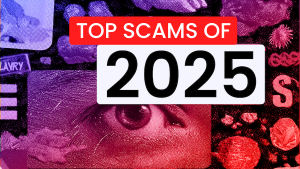It’s an all-too-familiar trap. You’re scrolling TikTok when an ad for your favorite shoe brand pops up. Black Friday and Cyber Monday sales are everywhere, and this one—buy one, get one free—looks completely legit.
The site it links to looks real too. The logo, the product pages, even the checkout cart all match what you’d expect from the brand. You place your order and move on.
A few days later, you notice the charge on your bank statement. It’s the right amount—but the payment didn’t go to the store you thought. Instead, there’s a company name you don’t recognize.
That’s when it hits you: the site wasn’t real at all. You’ve been scammed.
Peak shopping season is peak scam season, with fake deals and ads making up one major tactic used to deceive shoppers.
Nearly all U.S. adults plan to shop online this season, with about half planning to do so daily or more. Scammers know that when people are rushing to buy gifts and click “checkout,” they’re also less likely to slow down and verify what they’re seeing.
That’s when fraudsters strike, often using artificial intelligence to make their fake messages and websites look authentic.
McAfee’s 2025 holiday shopping research revealed that almost half of Americans (46%) say they’ve already encountered these AI-powered scams while shopping.
How AI is Powering Holiday Scammers
The era of “obvious scams” is over.
Generative AI tools have made it simple to clone brand websites, copy influencer voices, and even create realistic video ads promoting fake sales. And our recent State of the Scamiverse research found people struggle identifying deepfakes, with 39% of people saying deepfake video scams are getting more sophisticated and harder to spot.
That’s why deepfake-driven scams utilizing advanced tactics are multiplying across platforms like TikTok and Instagram. Scammers are impersonating celebrity likenesses, or well-known brands, to advertise “exclusive” promotions or fake giveaways. For holiday shoppers, the line between what is authentic and fraudulent continues to blur.
By the Numbers
- 1 in 5 Americans say they’ve been scammed during a past holiday season
- The average loss per victim is $840
- 57% of those surveyed are more concerned about AI scams this year than last
- 38% of those surveyed believe they can spot scams, yet 22% have fallen for one
- Detected deepfakes surged 1,740% in North America last year
What to Watch For in 2025
1. Fake Retail Sites and Counterfeit “Deal” Pages
These scams mimic major brand websites down to the logo, product photography, and even customer service pages. The only difference is the URL—a single extra letter or misplaced period (“target-sale.com” instead of “target.com”).
When shoppers enter their payment details or passwords on these fraudulent websites, that information goes directly to criminals. According to McAfee research, this fear of scams while shopping has stopped 40% of consumers from completing a holiday purchase.
How to spot it: Always check the full web address, look for “https,” and avoid clicking through from an ad or social post. It’s best to just type the retailer’s name directly into your browser instead to reach the official site.
2. TikTok and Social Media Scams
Even cybercriminals follow trends, and short-form videos are scam hotspots. Scammers use deepfakes or stolen influencer content to make “exclusive” deals look legitimate.
For example, a TikTok clip may show a celebrity promoting a discount code that redirects to a counterfeit store.
According to McAfee research, 1 in 5 people (20%) say they or someone they know has fallen victim to a deepfake scam in the past year. And overwhelmingly, respondents said they came across deepfakes on social media.How to spot it: Check if the creator’s account is verified. Look at past posts and engagement patterns. Real brands rarely share one-off videos with unfamiliar links.
3. Delivery and Shipping Text Scams
You’ll receive a text saying a package can’t be delivered or that a small fee is needed to confirm your address.
McAfee found that 43% of people have encountered fake delivery notifications, and many victims say they entered credit card information thinking they were resolving a legitimate issue.
How to spot it: Real shipping companies rarely send texts with clickable payment links. Visit the carrier’s official website or app to verify any delivery problems.
4. Gift Card and Account Verification Scams
These scams pressure you to “verify” your account or make an urgent payment. Messages may claim your PayPal or Amazon account is locked and request you to confirm details. Others ask for gift cards to “resolve” a billing issue.
Scammers count on urgency—once you send a code or card number, the funds are gone instantly.
How to spot it: No legitimate company will ask for payment in gift cards or ask you to share one-time codes over text. Always log in to your account directly, never through a link sent via message.
How to Shop Safely This Holiday Season
Go straight to the source. If you see an offer on social media, type the retailer’s URL yourself instead of clicking through the post. Fraudulent ads often lead to look-alike domains.
Pause before you click. Take a moment to verify emails and DMs. Check the sender’s address, look for misspellings, and hover over links to preview where they lead.
Use AI to fight AI. McAfee’s Scam Detector can identify suspicious messages, fake websites, and deepfake content before harm occurs.
Keep your software up to date. Many scams exploit outdated browsers or apps. Regular updates patch vulnerabilities before criminals can use them.
Avoid public Wi-Fi while shopping. Public networks are easy for hackers to monitor. Use a secure or mobile connection instead. Check out McAfee’s VPN to stay protected while browsing and shopping.
Never pay with gift cards: Legitimate companies and businesses will never ask for you to pay or verify a purchase in exchange for gift cards.
Be suspicious of requests to pay with crypto: A legitimate company will not force you to pay in crypto or other specific crypto assets.
How McAfee Can Help
McAfee’s Scam Detector uses advanced artificial intelligence to automatically detect scams across text, email, and video. It blocks dangerous links, identifies deepfakes, and stops harm before it happens.
McAfee’s identity protection tools also monitor for signs that your personal information may have been exposed and guide you through recovery steps.
You can sign in to your McAfee account to scan for recent breaches linked to your email, or try a free trial of McAfee antivirus to keep your devices secure throughout the shopping season.













